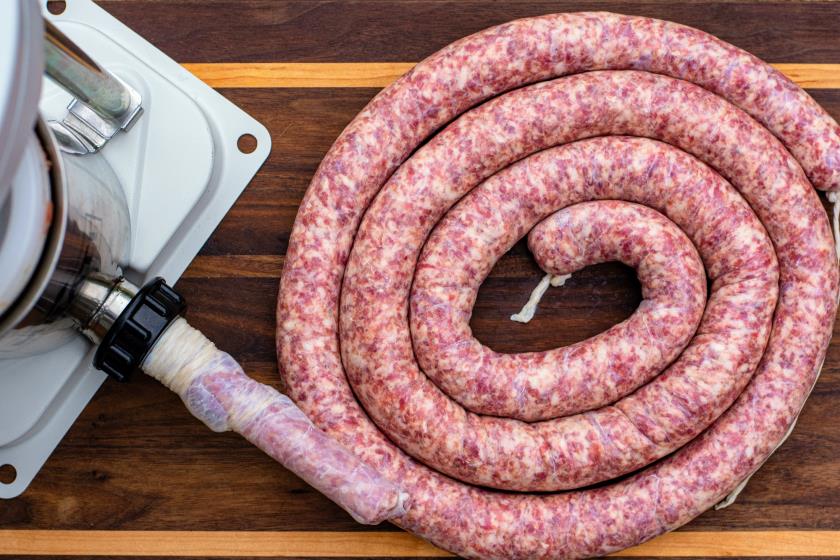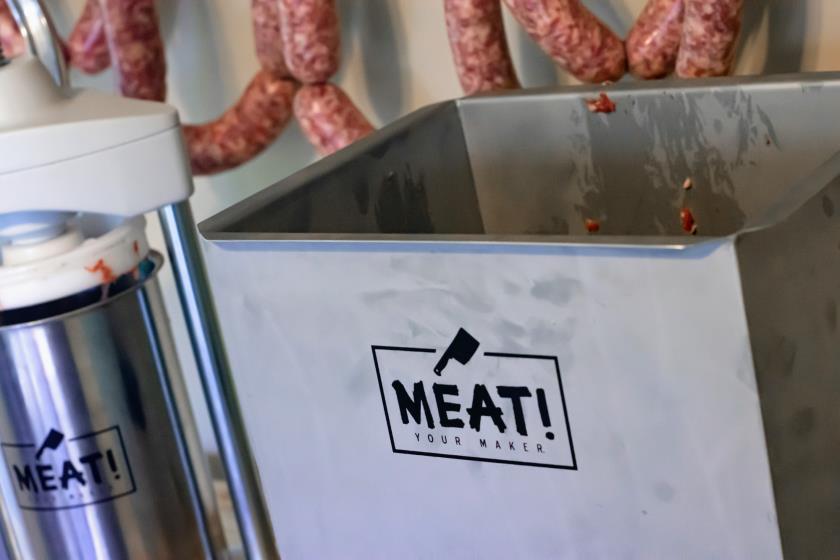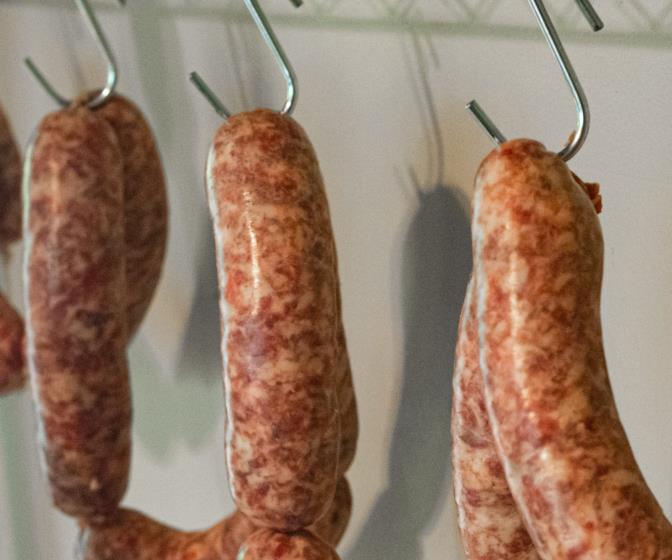
Print Recipe
Making great venison bratwurst, or any sausage for that matter, is an art form, in my opinion, one that begins with precision. While I feel most great wild-game cooking requires little else besides fire and salt, a greater degree of knowledge and patience is necessary for venison sausage. In my head, it’s the difference between a caveman and a chisel, versus an architect and his or her mechanical pencil.
Months ago I stood in awe – like a kid watching a clown making balloon animals – as Joshua Smith, co-owner of the Barred Owl Butcher & Table in Columbia, MO, took a coil of sausage and effortlessly tied and braided 15 pounds.
Later, he shared his bratwurst spice mix recipe with me, and I used it for a blend of whitetail and pork fat. End result: Amazing. Below are his insights:
“I prefer to use metric weights and a good digital scale (bonus points if it is accurate to the half or tenth of a gram) for measurement in my sausage and charcuterie projects,” Smith said, “as I find it to be much more reliable than a system of cups and tablespoons as it is both easily scalable (just move a decimal point) and because volume and weight don’t directly correspond from one brand/style of salt to the next.”
Amount (in grams) Ingredient Charcutier’s Percentage 10,000 g 60:40 Venison to Pork Fat 100% 180 g Fine Sea Salt (or pure Kosher salt) 1.8% 30 g Ground White Pepper 0.3% 20 g Ground Ginger 0.2% 20 g Ground Nutmeg 0.2% 10 g Ground Marjoram 0.1% 10 g Ground Celery Seed 0.1% As needed 29-32mm Hog Casings n/a
Professional meat processors “build” their sausage using the percentage method, as shown in this recipe. Meat is always 100% and ingredients are based on that. For example, if five pounds of ground venison blend (three pounds venison, two pounds pork fat), reads 2,268g on the scale, I would need:
- 40.824g fine sea salt
- 6.804g white pepper
- 4.536g each ginger and nutmeg
- 2.268g each marjoram and celery seed
“I would round all of these to the nearest whole, half or tenth of a gram depending on the capabilities of my scale,” Smith suggested.
Yes, you can “fake it” without a digital scale, and I personally have done that, but you’re risking something being “off.”
Making venison bratwurst is more than just grinding and blending. There are a few rules to follow and some tips that make things easier. While it may look daunting, sausage making is actually easy once you have the basic process down.
Venison Sausage-Making Steps and Tips
- Fat content is up to you. Some folks run with as low as 20%, while I know others go as high as 60% (or higher).
- Inquire with your local butcher about picking up pork fat (not pork meat, but just the fat), as it is a must for quality wild sausage, in my opinion.
- Invest in hog casings, not collagen, for bratwurst.
- Use quality equipment. MEAT! (meatyourmaker.com) sells commercial-grade tools direct to consumers so there are offerings at a lower cost. I have found lower-quality equipment simply leads to quicker frustration.
- Invest in a meat mixer, versus your hands, to mix together ground meat and spices.

- Plan to devote at least a few hours to this process. (Read: have ample beer on hand.)
- Keep the meat VERY COLD throughout the entire process. I personally prefer to grind, mix, and stuff when the meat is still very slightly frozen. Others put thawed meat in freezer for an hour or two before starting, and freeze for an hour between each step.
- If running a commercial-grade grinder (i.e., one with a motor that produces heat), consider freezing all grinder parts that will come in contact with meat (e.g., chute, grinding plates, etc.). Otherwise, if grinding several pounds, the motor can cause parts to heat up and thus potentially turn your meat to mush.
- Some folks spice their meat before grinding. Some of these folks are the same who stuff sausage using their grinder. I opt to grind, then mix thoroughly with a meat mixer. It’s your call. (Meat mixer means you aren’t adding heat from your hands to meat.)
- Follow the directions on your casings for rinsing and soaking and sliding onto stuffing tube.
- After grinding, when meat mixing in mixer, add spices gradually and mix until spices are absorbed and meat is adhesive, almost sticking to your hand (but still, ideally, very cold).
- When it comes to stuffing, sometimes it helps to work with a partner, though this isn’t essential. While one person cranks, the other can concentrate on easing the casing off the stuffing tube and filling at desired speed (this does require communicating with the cranker).
- Leave tag end (one hanging off tube) untied, as air will come out stuffer ahead of the meat, and it needs to escape.
- Error on side of under-stuffing versus over-stuffing casings. With over-stuffing, you risk breaking casings when filling or twisting to tie off links. With under-stuffing, you can always direct meat through casings when it’s time to twist and tie off links.
- Let the meat come out in one long sausage and spin gradually so it settles in a coil.
- When finished stuffing and ready to spin and tie links, tie your tag end with an overhand knot.
- Use a fine needle of some sort to pop air bubbles (I’ve found this also helps prevent casing bursting when twisting).
- Pinch links to size of 6 inches and spin one direction then alternate spinning direction for next link (so not to unravel previous link).
- Tie other end when finished twisting links.

- Ideally, allow sausages to hang without touching for a few hours then place in fridge overnight so casings can tighten. Casings must sit for approximately 24 hours before you can cut links.
- Even if casings burst, don’t fret – those sausages are indeed salvageable, if not a huge burst, and great with this below recipe. (They just won’t look as pretty.)
Wisconsin-Style Venison Brats and Hard-Cider Kraut Recipe

Ingredients:
- 4 (6-inch) venison brats
- ½ green cabbage head, core removed
- 36 ounces preferred beer
- 36 ounces preferred hard apple cider
- 1 tablespoon kosher salt
- 2 tablespoons freshly ground black pepper
- 1/2 cup malt vinegar
- 1 medium yellow onion, sliced
Get the Recipe: Wisconsin-Style Venison Brats and Hard-Cider Kraut










































